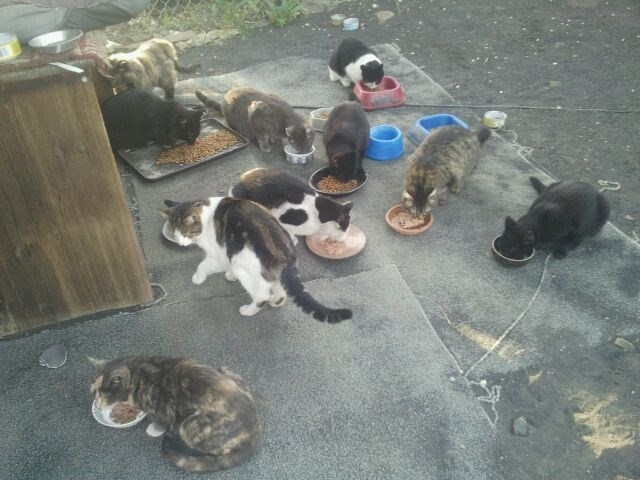
Feeding time at Tom's feral cat colony.
Image Credit: Contributed
May 14, 2015 - 2:34 PM
VERNON - There’s Blackie, and Boots, Tigger One and Tigger Two, and of course Mr. White, a Siamese whose ears are wrinkled by frostbite. They, and the other dozen or so cats make up the band of misfits, just some of the tens of thousands of feral cats in the North Okanagan.
They have it better than most. They were lucky enough to find their way to an equipment yard in Vernon where the owner took it upon himself to care for them. Tom, who didn’t want us to use his real name, says it all started about 18 years ago with a couple cats. Being a cat person, he went out and bought food for them. He then tucked a mattress and bedding underneath his office and built a little cat door so they could find shelter from the cold.
“Lots of them are wild cats, you can’t go near them or they’ll start hissing and clawing,” Tom says, noting they were probably born in the wild. “But some of them are very friendly, and you know they were probably other peoples’ cats before and they were abandoned.”
Right now, he cares for about 16 cats. The number fluctuates from year to year, and season to season, and Tom figures he’s probably sheltered around 40 different cats over the years.
“Somebody has to help them, they can’t do it on their own,” Tom says. “Everybody says I’m crazy, but I always tell them ‘I have no mice,’ so there’s that bonus to it.”
They keep to themselves and he doesn’t see too much of them during the daytime. But if you look at his overnight video surveillance, you can see the yard is a jungle gym for the four-legged acrobats.
“They climb on everything, it’s hilarious,” he says.
One of his favourite parts of the day is arriving in the morning to see what crazy places they’ve left their paw prints — often precariously high pieces of equipment. They’re always there to greet him at the gate in the morning and follow his truck to the breakfast spot.
He spends about $100 a month on food, and for a long time paid to spay and neuter them completely out of his own pocket. Now, the Vernon and District Animal Care Society helps him out, and they’re happy to do so.
President Reid Harvey says the society has been working to keep feral cat populations in check since it formed in 2001. It operates a Trap, Neuter, Release program in which humane traps are loaned out to people like Tom, and used to transport cats to the vet to get fixed and tattooed. The cats are then returned to their home territory, or colony.
“If we didn’t have people like him caring for them and doing this, the population goes unchecked and just continues to grow,” Harvey says. “There are literally tens of thousands of ferals in the North Okanagan, it’s mind boggling.”
Feral cats are the offspring of domestic pets who were abandoned by their owners, often families who don’t realize how expensive it can be to have a kitten, Harvey says. Feral cat colonies can range from several, to dozens, to over 100 cats, and there are lots of them around the North Okanagan. Populations are also rampant in the Kelowna area, where a newly formed coalition estimates there are around 13,000 feral cats.
Feral cats do help keep rodent populations at bay, but can quickly get out of control. One female cat and her offspring can, in eight years, give birth to over 2-million kittens, Harvey says.
“(Trapping and neutering) is the only practical and humane solution,” Harvey says. “The alternative is the words no one wants to use — culling or mass euthanasia.”
In the long run, the Trap, Neuter and Release program is actually less expensive than mass extermination, he says. The care society also runs a spay and neuter assistance program for low-income families with the aim of preventing the growth of feral populations in the first place.
In 2014, the society fixed a total of 890 animals, of which 381 were cats through the assistance program, and 342 from the feral cat program (the society also spays and neuters other animals). It’s an ongoing battle, but Harvey believes the efforts are making a difference in keeping feral cat populations in check.
While most ferals are completely wild and unfit for the life of a house cat, if taken in young enough, kittens can be domesticated and adopted out, something Tom has watched happen with his own colony.
“I’ve talked to people who still have the cats and they are loving them, so there are those happy endings,” Tom says.
And for those not accustomed to the life of a typical house cat, there’s always Tom’s band of misfits and their metal jungle gym.
For more information about the Vernon and District Animal Care Society, or to access its services, click here.
To contact the reporter for this story, email Charlotte Helston at chelston@infonews.ca or call 250-309-5230. To contact the editor, email mjones@infonews.ca or call 250-718-2724.
News from © iNFOnews, 2015